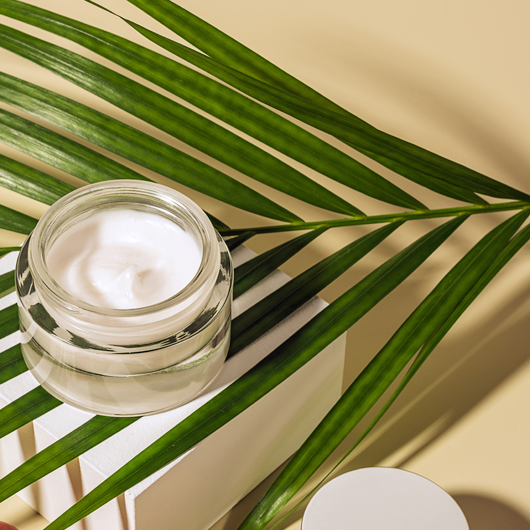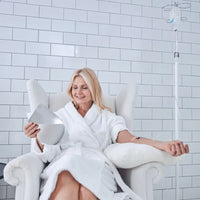What are Wrinkles?
When your skin starts to age, one of the first things you begin to notice is creases and wrinkles that stick around even when you aren’t making any facial expressions.
While experts still don’t fully understand what causes a wrinkle, there is an agreement that they are caused by the loss of collagen and hyaluronic acid in the supportive dermis of your skin.
Many people erroneously believe that wrinkles happen as a part of aging, but only 10-20% of aging has to do with genetics. In actuality, the rate at which you age can be determined by your life choices. Aging and environmental insults cause the collagen in your dermis to break and become disorganized. When this happens, the dermis is less pliable and doesn’t bounce back as quickly. When we get older, our collagen production also slows. The stores of good collagen become depleted, and wrinkles form. The less collagen we have, the bigger the folds get.
There are many steps you can take to prevent and reduce the look of wrinkles. Protect your skin from UV radiation, consuming healthy skin foods, exercise, nourish your skin with the right skincare, and occasionally getting an in-office treatment with your Board Certified Dermatologist, the expert in skin health. Some ingredients are specifically meant to target by smoothing and filling in problem areas. Lines are a reality, but they don’t have to be a problem.
You can increase collagen production naturally. These ingredients boost collagen production by providing nutrients that the skin needs to protect and regenerate itself. For those who don't have time and need instant gratification, there is an alternative.
Wrinkle Fillers and Injectables
If you have ever been interested in dermal fillers, here is the truth about the currently available wrinkle fillers. Technology is continually evolving, and this area is hot, with new products coming out every other month!
In addition to using the best skincare, the loss of fat and bone on your face may cause a bit of deflation and sagging of the overlying skin. This is where dermal fillers play their best role – in helping to re-volumize your face. While there are inherent risks with any procedure, dermal fillers may be a safer and more natural option than you think.
We want to empower our readers with the knowledge of what is going to be the best, most efficient anti-aging treatment for each. We all know that when we look good, we feel good. Somewhere around our 40's, we begin to see significant changes happening to our complexions.
Even if we can't visibly see deep-set wrinkles, our bodies are showing the signs of aging. Tiny little crow's feet, eyebrow furrows, laugh lines, forehead lines, droopy eyelids, you get the picture.
Here is a look at the newest innovations in dermatology. Wrinkle fillers and injectables are extremely popular as they fight age-related volume loss. They are FDA-approved. Although they sound extreme, some are more natural than others. And probably more natural than you think.
Many types of injections can help you look instantly younger by adding proportionate shape and volume to your face. Facial rejuvenation enhancement is the best alternative to a surgical facelift. Dermal fillers can help restore the natural volume your look once had. Those who have had these procedures done rave about the instant volume, lift, and reshaping of the face.
Remember, none of these non-surgical treatments come without pain. Injections are painful but may be minimized by applying a topical numbing cream before the procedure. These anti-aging procedures should only be performed by a professional—one who has the credentials and experience. You will need to ice the area after injection. You may want to consider bringing an ice pack, although most Dermatologists will give you one after the procedure.
Some treatments come with significant swelling. Swelling may occur when injections are done on the lips. Plus, you may see bruising at the injection site. Yes, depending on the area treated, you may look like Marge Simpson for a day or two. They also require aftercare appointments.
All wrinkle fillers and dermal fillers can have side effects. You can also request the use of a cannula, a small needle with a blunt tip, that helps to reduce bruising.
Finding the right injector is the key. If you are serious about getting injections, finding the right person and the right filler are equally important. For an injector, you want to find someone who has had a lot of experience. Not just years in business, but lots of clients who have results that appeal to you.
State regulations vary widely, and just because someone is an injector doesn’t mean they do it artistically and naturally. It is best to aim for a global effect and not chase lines as this may throw off your face's natural proportions.
They often have a better knowledge of facial muscles and know the right placement of the filler. Office visits are less stressful if you know you will get a good injection, the right lift, plus less bruising, swelling, and pain.
Recommend removing this section as a specific injection technique, and medical advice is not advisable.
The best injectors have the happiest returning clients who consistently come back every 2-6 months. This person should be natural to talk to and listen to your concerns. They should also advise what product will work for you, even if it isn't a product that they carry.
Some injectors will only use one line of products from one manufacturer like Juvederm and don't offer other kinds of fillers. Others will offer a variety. Now, onto finding the right filler.

Voluma:
Juvederm creates Voluma; it is a hyaluronic acid-based filler. It works best on cheeks and under-eye hollowness. Voluma lasts two years and costs $1000.00 per syringe.
Currently, it is the longest-lasting Hyaluronic Acid dermal filler on the market. Most people will need two syringes (one for each cheek). If you have laugh lines, you may want to consider Voluma. It offers a visible lift on the cheekbones, which lifts and smooths out the laugh lines.
It is a very thick and pliable HA. Hyaluronic Acid works by giving collagen the nutrients it needs to be healthy. The results are a fuller complexion with restored volume. The added fullness corrects facial wrinkles.
However, if the lines around the mouth are severe, you may also need 1 or 2 syringes of Juvederm Ultra or Juvederm Ultra Plus in addition to Voluma for a complete transformation. Voluma is the newest filler on the market.
It is wildly popular because it is very natural-looking when injected correctly. There have been reports of delayed swelling and redness that are difficult to treat. Ask your physician about this during the consultation. Nonetheless, Voluma will have you looking 5 to 10 years younger in just one trip.
Radiesse:
Radiesse is a wrinkle filler comprised of Calcium Hydroxyl apatite microspheres. Calcium Hydroxyl apatite is the main component of our teeth and bones. The calcium is in a gel with water, glycerin, and sodium carboxymethylcellulose.
Designed to add volume to the mid-face, it restores a smoother appearance and fuller cheeks. The gel does get absorbed into the body, usually in about a year. But the microspheres are particles left behind and can stay in your face for up to 7 years.
Those remaining calcium spheres stimulate your face to make more collagen, and thus results can last longer than a year. Most patients need two syringes, one for each cheek.
The cost is about $700-$900 per syringe. Radiesse has been the leading filler for cheekbones until the appearance of Voluma and Restylane Lyft. It is beneficial for many different areas and is excellent for filling the back of the hands. Unlike the HA fillers, Radiesse is not reversible with an enzyme, hyaluronidase. Making Voluma and Restylane Lyft more popular with estheticians and injectors.
It is beneficial for many different areas.
- marionette lines
- nasolabial folds
- cheek, chin
- temporal lobes
The key to getting a good result is to use a physician, particularly a Dermatologist, who is very familiar with Radiesse and has done many injections. If not placed correctly, more side effects can result. Small cysts can form under the skin (which is rare), but this is why it is not recommended for lip augmentation or under the eyes.
Juvederm XC:
Or non-animal stabilized Hyaluronic Acid dermal filler. The most natural-looking results of all wrinkle fillers and the most natural feeling. Your skin naturally contains Hyaluronic Acid, and Juvederm can add volume to correct facial wrinkles and folds that appear around the mouth and other areas of the face. It does not have the lifting capacity seen with Voluma. This is why they are used in different areas of the face.
You can expect results to last about a year. Juvederm can be used for various applications, including lips, laugh lines, under-eye hollows, cheeks, and more. Similar fillers include Belotero Balance, Perlane, Radiesse, and Restylane.
A syringe of Juvederm can range from $500 to $600.00. One syringe is needed to fill the lips, and two syringes are often used for marionette lines.
Vollure:
Vollure is a newer filler from the same company that makes Juvederm. It uses the technology of Voluma and has the natural softness of Juvederm.
The best part is that this dermal filler can last up to 18 months. Long-lasting new Hyaluronic Acid technology is making it more affordable, with fewer infections over time. It has the same feel as Juvederm XC; it's easy to use and mold for the injector plus has a longer lifespan.
Vollure is also an excellent choice for the lips. It is said to have less bruising and swelling at the injection site than other dermal fillers. A tube of Vollure typically will go for $500. up to $750. One tube for the lips, two containers for the fine lines, and wrinkles in the labial folds.
Volbella
Volbella is another new filler to hit the market recently. It is thinner than Juvederm XC. Why a thinner dermal-filler? Juvederm does a fantastic job of providing additional volume and plumping up areas, and encouraging collagen production that has decreased over time.
But there are times when one doesn't want or need all that extra volume. One place is on the lips. Some people want a more natural look, which is where Volbella comes in.
This is the thinnest filler from the Juvederm line. Injectors love the ease of use as they can have more control and place the correct amount exactly where it is needed. It can be hard to work with some fillers such as Radiesse as if they are misplaced; it can cause a not so great result.
Volbella is also used off-label for the under-eye hollows or tear troughs. With its very natural look and thin texture, it a no-brainer why med spas are using it to fill in the look of circles under the eyes.
Restylane
Restylane is similar to Juvederm but produced by another company. Restylane is the best alternative to Juvederm. It has been the go to filler for those who metabolize Hyaluronic Acid fast. It uses two forms of Hyaluronic Acid, a gel and NASHA (non-animal stabilized Hyaluronic Acid). It comes in many different types of specific treatment areas.
The most common is Restylane Lift for the midface, smoothing severe facial wrinkles and nasolabial folds. Restylane Silk for the enhancement of the lips with lip augmentation. Users report it to be long-lasting, lasting at least 12 plus months.
Collagen
The first substance is used as a filler. It provides firmness and replaces areas where the dermis has lost its support and developed wrinkles. Common names include Zyderm, Zyplast, Cosmoplast, or Evolence. It is usually obtained from bovine sources but may also be from human or porcine.
The downside of collagen injections is that you may have to be tested for allergic reactions depending on the source. It also only lasts about three months. Porcine collagen (from pigs) is a newer form available and can last up to 12 months. Collagen is most known as a lip augmentation filler. Because of the numerous options available nowadays, collagen is generally not used anymore.
Sculptra
Also known as Poly-L-Lactic acid is a synthetic alpha hydroxy acid. Sculptra replaces the loss of volume in the temporal lobes and other areas of the face. Poly-L-Lactic Acid stimulates the body to make new collagen. It takes about six months to see Sculptra full benefits as it boosts the skins collagen production and adds volume over time.
Botox or Botulinum toxin:
Active ingredient: botulinum toxin, type A. The inactive ingredients are human albumin and sodium chloride.
It's a purified protein. The one you are probably most familiar with, other brands that work similarly, include Xeomin, Myobloc, and Dysport. Botox relaxes the muscles in the face, so they do not contract. It can also be used to control sweating.
Clinical trials have even begun as an option to treat migraines and even teeth grinding. Botox lasts for two and a half to 3 months. However, if you use it regularly, it can last anywhere from 3 to 4 months on average. For some, one treatment can continue up to 6 months. The general cost is about $10 to $12 per unit.
Botox is injected into specific areas. For crow's feet, you will need 20 units. For a cheek lift, the esthetician will use anywhere between 4 and 12 units. You would need another 20 units for eyebrow furrows and another 2 to 8 units for droopy eyelids. A Browlift will use anywhere between 8 to 12 units. Bunny lines, two units. The chin is usually two units.
For a full non-surgical facelift, expect to have 45 units or more injected. Recently, Botox has even been approved to be used for sweating and migraines. The esthetician will sterilize the desired area with a swab of alcohol. Depending on the area's size, the esthetician will inject the Botox into the face 2 to 10 times. The technique is crucial.
The more experience the esthetician has, the better they know how to place the Botox correctly for a better result. It will take five days after the injection to get the full effect. If you're not ready for needles or want a topical alternative to Botox, try our Expression Line Deep Wrinkle Serum.
Botox can have some severe side effects:
- bruising
- bleeding
- droopy eyelids
- dry eyes
- redness
- itchiness around the injection site
Dysport:
Another injectable new on the horizon is Dysport. It has the same paralyzing effect as Botox, but it's not as potent. This means you get a more natural appearance, and your facial expressions will still be seen, won't be as pronounced. However, if you prefer Dysport, you can use more units to receive the same effects as Botox.
Twenty units of Botox is equal to 50 units of Dysport. Many med spas charge $10 to 12 dollars a unit (the same cost as Botox). If you need 50 units of Dysport, you are better off using Botox as the less expensive option.
Injections most used for the specific areas of the face: 
- Lips: Juvederm is the leading injection because it is the most natural-looking and feeling. For those who want a more natural look using Volbella.
- Cheek Bones: Voluma or Radiesse
- Marionette Lines: Juvederm XC or Vollure
- Wrinkles and Crow's Feet: Botox
- Tear throughs or under-eye hollowness: Volbella
- Under Chin Area (turkey neck, double chin): Kybella
- Temporal Lobes: Sculptra
Dermal Filler Treatment Area Average Usage Chart
Area/Syringes needed.
- Forehead 1-2
- Temples 1-2
- Cheekbones 1 each
- Nasolabial folds 1-2
- Jowls 1
- Chin 1
- Under-eye hollows 1-2
- Lips 1-2 (1 for a more natural look, 2 for a fuller look or skinny lips.)
- Nose 1
- Under-eye 1-3
There are many types of wrinkles fillers on the market.
If you are interested in instantly rejuvenating your face, it is in your best interest to learn about what they consist of and how they work, and the correct placement. Knowing the right filler to use will only improve the result.
Do your due diligence and find an injector who has the experience and know-how. An experienced technician will tell you if your goals can be met, don't settle for someone who will tell you what you want to hear. Injections need to be maintained and can be costly.
Choose wisely. If you find that you metabolize Hyaluronic Acid too quickly, there are more permanent solutions like fat injections.
Sources:
https://www.aad.org/cosmetic/wrinkles/botulinum-toxin-overview
https://en.wikipedia.org/wiki/Injectable_filler
This article has been reviewed by Dr. Jen Haley, a board-certified dermatologist.
About Skin Perfection
We’re here to help you create clean beauty products and get you looking younger. We’ve put together our best tips for making your own skincare products, finding the best anti-aging ingredients, plus in-depth videos and guides.
Learn more about our team here.








